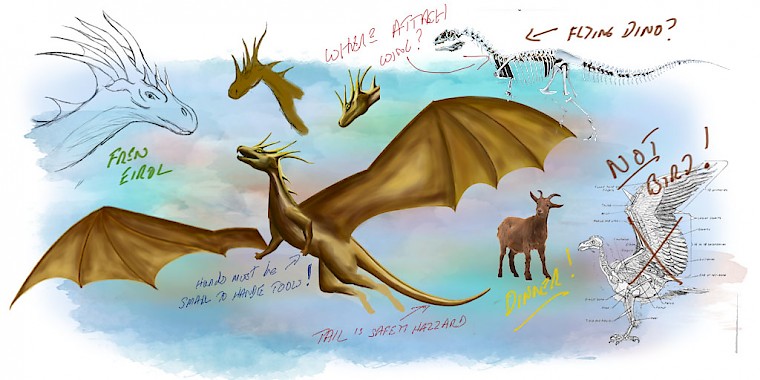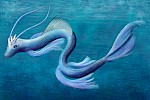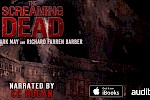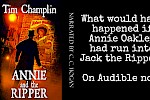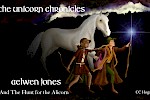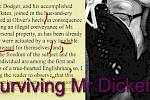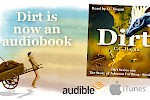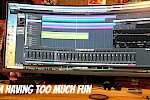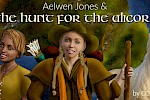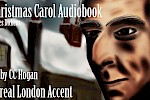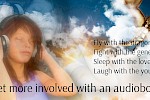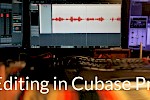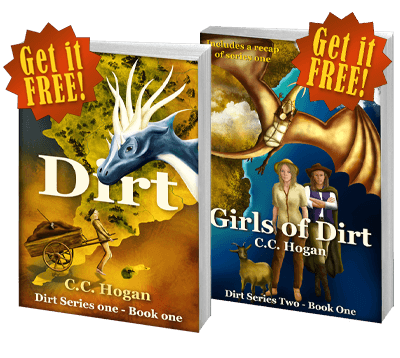It is far more than just claws and paws
Learning to draw dragons as a non-artist is an uphill struggle. Things like arm-leg proportions are hard enough, but since they are also hexapods, there is the annoying problem of where exactly do I stick their wings?
From the drawing point of view, my starting place is an allosaurus. It has the right proportion of arm length to back leg length, has a spectacularly long tail, and I know that it can stand upright without falling on its nose - it did, after all, a few million years ago.
But me attempting to draw the damned thing comes a long time after trying to invent the beast in the first place, and the rest of the process has been far more about what I need my dragons to achieve in the stories of Dirt and how I can manage to make them realistic.
Looking back at a rather hit and miss process, I could have come up with a checklist which may have made my life easier.
- How big is the creature?
- How many people can it carry?
- Where do riders sit (and how do they hang on)
- What does it eat?
- How does it eat it?
- Where do baby creatures come from?
- How fast do they travel?
Alright, that is a starting point, but this list could apply to designing a horse as much as anything else. My dragons (and indeed my creatures called Callistons) are intelligent, cultured people, and that raises a few more questions.
- What do they sound like?
- How do they manipulate tools?
- How do they house themselves?
- How fast do they travel?
- How do they interact with each other?
- What clothing do they wear?
- Where do baby creatures come from?
You will notice that I have asked two of the questions twice and I will explain that a little later on.
A creature who has the same level of brain power as we do will have needs that go far beyond a beast of burden; just as we have needs that eclipse those of the dog, or even the ape. All animals seek shelter, and some, like birds, construct a place to stay, but only humans take this to a level of fussiness that surpasses pure practicality. Out of all the beasts, only humans wear clothes, though animals might burrow beneath clothing (ours) to keep warm. Quite why we wear clothes is a little bit of a puzzle, but the best guesses link an evolutionary trend towards hairlessness combined with a brain powerful enough to solve the problems of hairlessness, like cold and sunburn.
Humans have also changed the way they eat. From the moment of discovering how to make fire on command, we have been cooking. Cooked meat tastes better than uncooked meat (without needing to season) and has health benefits. Brainpower steps in again and we have learned to cultivate food that benefits us most and that we like best. This has reduced our need to hunt which is a hit and miss affair and runs the risk of dinner fighting back. Humans are small and weak and not natural hunters without tools.
I could carry on listing all the things we do that animals do not simply because our reasoning powers make us question the status quo, but you get the idea by now. If my invented creatures are also intelligent, then all the arguments that apply to us, apply to them as well.
A Question of Size
Before I decided anything else about my dragons, I had to work out how big they are, or can be.
I wanted them impressive, but more importantly, I needed a dragon that could carry two people and provisions for three people - two humans and the dragon. Now, if you take a very big cart horse, they can carry two people and some very basic bits and pieces at a push, but two horses is better. If I make the dragon twice the size of a horse then I am possibly heading in the right direction, but as someone in one of the books comments, "your horse doesn't have to fly."
Flying is a huge part of the size argument. The energy required to go upwards is significant - even walking up a hillside makes a big difference. Add weight that is not contributing and suddenly you need something much bigger and more powerful than two horses in size.
In my head, I could envisage a point of impossibility, in other words when the dragon can never be big enough because the dragon also has to carry themselves. Thankfully I was heartened by a series of photos showing a woodpecker flying off carrying a weasel that had jumped on its back. Although the bird was unlikely to fly far, it showed me it was possible.
My dragons still needed to be big, however, especially if they were also going to carry bags and fly for several hours at a time. This would also add limitations, which was rather useful. In my story, one of the faster dragons can, like certain birds, stay in the air for many, many hours, flying at a good speed. But add a couple of riders and a bag of belongings and the dragon is going to be tired after a few hours and need to rest. Why was this useful? In any story, as soon as you introduce something that is all but unassailable, your plot has the potential of falling apart, logic-wise, unless you just ignore your own creations. If my dragons were able to fly at high speed for days on end, then my heroes would have caught their quarry within hours, would be able to hit at the enemy with impunity, and my book would have become a very short and boring story.
Habits and Needs
If your creature, dragon or otherwise, is intelligent, they will also be habitual. We all are; sometimes because of necessity like eating or keeping warm and sometimes through vanity like preferring certain coloured cloth. Your creature's habits will affect your plot one way or another, even if it's just stopping for lunch.
I had already decided that my dragons were big, Fren-Eirol is the size of a cottage and the red dragons are bigger still, so their day-to-day needs were going to be equally as big. Whole goat, anyone?
I decided that dragons do not eat everyday, especially when flying a lot, but they cannot starve and dinner times are going to be impressive. If you want your goat roasted, then you don't quickly fry it off in a pan but will have to cook it for several hours over a fire or in a very big pot. This applies to everything. My lot like their beer, but they drink it by the barrel. So food takes time, especially out on the road. This also could have been a huge problem when it comes to population numbers; 100 dragons are going to need a much larger area for hunting and farming than 100 humans, enough that it simply is not compatible. So, I needed to steal a trick from our own history to balance this out and have humans much more numerous than dragons in the same way as mammals became more successful and numerous than dinosaurs.
Clothing was another issue that I played with. My dragons are not reptiles and do not have armoured, scaly bodies. They are completely hairless, smooth-skinned creatures, which is possibly a little pushing my luck in the plausibility stakes. However, in consequence, they do like clothing for the same three reasons we do - protection, keeping warm, and vanity. But, I really could not see something Allosaurus shaped in a tux.
My solution was for dragons to be immodest and to basically parade around in the nude, like most animals. I also allowed them very high tolerance to cold, though some are better than others. But these are intelligent creatures who, like us, are sometimes less than logical; they might be able to tolerate rainstorms, but that does not mean they like them! So my dragons do wear some clothing. Desert dragons wear thick hides, partly to protect them from stray arrows but also to give their riders something to hang onto in a fight. Sea dragons like wearing silks, purely from an aesthetic point of view. Red Dragons sometimes wear leather for practical reasons.
Speed
This was one of the most important decisions I had to make as it would make the greatest impact on my story, as I mentioned earlier.
I really did not want my dragons getting to places too quickly, and I had to stop them being able to fly ridiculous distances in one go, at least carrying someone. It is a little like the horse; as a creature it can go very fast, but it needs to stop and rest frequently. You can rush over a long distance in one day, but you are going to be slower the day after and perhaps going nowhere the day after that. The horse has to be carefully paced and so does a dragon - more so, as they do not want to fall out of the sky!
In the end, I decided that cruising speed is around 30mph with a top speed of 60. However, this is airspeed, not land speed, so if they are going with the wind, you can add the wind speed to the airspeed. Some dragons are faster, most notably the Desert Dragons, but at full tilt, they cannot keep it up for very long unless they are at very high altitudes using the equivalent of the Jet Stream. Unfortunately, at those altitudes, the average rider will suffocate, so not a lot of help.
Limiting their stamina and speed has made my dragons a lot more vulnerable, and, I believe, adds interest to the story. This is why the question of how fast they travel appears twice in my lists - the first is the possible speed of the animal, but the second is how fast they wish to go. In one of my later books, one of the dragons sets herself a training regime to get herself fitter and faster, something no horse would do for themselves.
Babies and Society
So where DO baby dragons come from? Well, if I was to have a dragon society and intelligent dragons, then at some point this was going to come up.
I had already decided that dragons are not birds and reptiles and so do not simply lay an egg and get some, poor shmuck to sit on it. However, I never say they are mammals either. In the end, I went for live births but within a membrane sack that the mother helps the child break out of just after birth.
This, of course, begs another question about how the mother became pregnant in the first place. To a certain extent, I was relieved of this problem since although my human characters do have sex lives, we do not witness them outside of a good snog, but I could not ignore the point entirely. Although I do not detail it, we are made aware that dragons can and do love each other, and one dragon, in particular, is very fond of a bit of dragon romping. If you have intelligence plus "romping" ending up in baby dragons, that is also going to mean human-style emotions.
The bottom line here is that an intelligent creature is not going to want to be the ONLY intelligent creature. If you have intelligence, then the creature must have been successful (in evolutionary terms) and there must be more than one of it. Suddenly, baby dragons means you also have a society and everything that goes with it.
Do you really have to go to so much trouble?
There is a huge difference between a monster and a real creature, in my mind.
Monsters are unexplained animals that jump out at the hero at inconvenient points. Although it is nice if they make some sort of sense, there is no obligation on the writer to explain any of the details. Monster jumps out from behind tree, hero battles heroically to save the world, monster's corpse left on side of road.
Real creatures, however, affect both the story and the environment. They are part of the makeup of the world in the same way as humans are and so must have a plausibility about them. Otherwise, how or why on earth would they possibly be there?
That does not mean that you have to cover everything about them, at least not in the story, but it makes sense to at least work it out in note form so that not only the creatures make sense, you are able to develop the characters of that species properly. With humans, that is not needed since we know what it is to be human, but we do not know what it is to be a dragon or any other invented creature. If our characters are going to have depth and feeling, then we need to find out.
To give you an example, I make the point in part of my story that a dragon's perception of distance is very different to our own. When they are flying at 60mph at ten thousand feet (perhaps faster with the wind), then their horizon is not only farther away but is within easier reach than for the human walking along the ground in a valley. Yet, even though a dragon rider might be able to see what the dragon sees when riding, they will not instinctively relate to it in the same way as a dragon does. The same goes for height. For a dragon, looking down ten thousand feet is the same as looking forward ten thousand feet; they do not fear heights or feel disorientated in the way a human does.
Likewise, my dragons live several hundred years and have children very rarely. A dragon's perception of family, friendships and so on are on a completely different scale to our own. If I was to develop my dragon characters, I had to appreciate this, somehow, and that meant exploring and inventing.
So, if your big creatures are more than just monsters, think carefully what they can and cannot do and how they live. If it does not make sense, you could trip yourself up or even find yourself eaten by a pissed off beasty who just wants to be appreciated!

